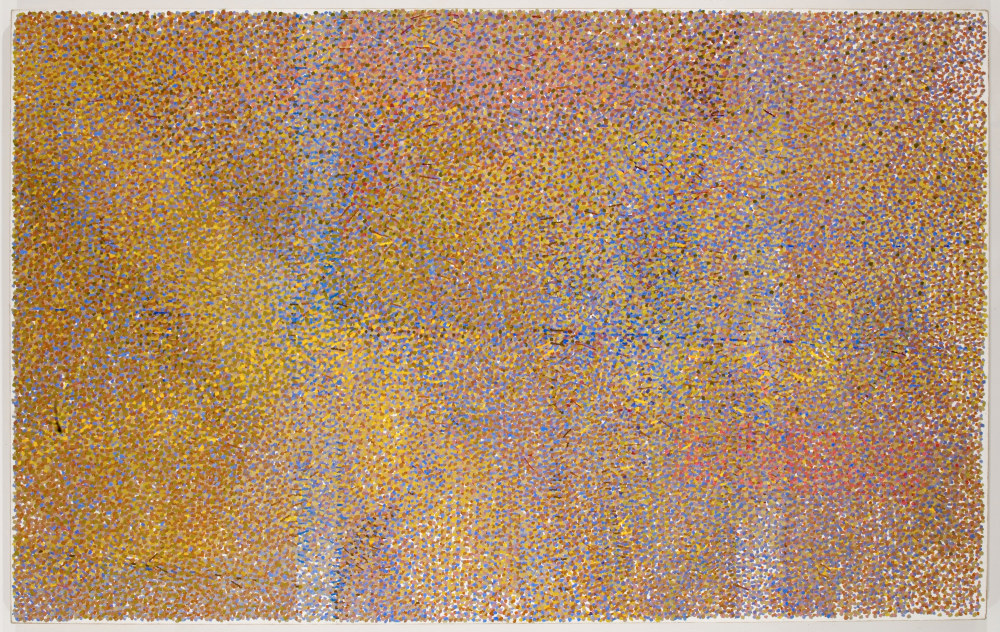
Andrew Forge, April, 1991-92, oil on canvas, 50 x 80 in. © Estate of Andrew Forge.
Andrew Forge Well, it’s a long story… As you know, since I started working with dots I’ve been very interested in the way in which the dot itself seems to invite different doings, in a sense. You want to look at them close, you want to see what the dots are doing when you got your nose stuck in them, then you want to stand back and see what they do at a distance… .
I’ve always found it interesting, and I’ve noticed that other people have found it interesting, to sort of wander about and to find that kind of middle ground between a long shot and a close-up (he laughs) and I’ve always rather treasured the fact that people seem to be engaged in that kind of dialogue with the paintings. I’ve always loved that.
Well now, alongside that, has been a long-standing interest in sculpture and particularly in the kind of experience that you have when you’re looking at a fairly frontal sculptural object. And of course my favorite things, that my mind always goes back to, are those Roman torsos that have lost their heads and lost their limbs and you just come across them in the museum stuck up on a plinth and there’s just this huge grade slab of … of a part of the human figure and the way in which the torso itself seems to somehow address your own physical presence.
I have always been very, very thrilled by that and back in the mid 80s I painted a bunch of paintings that related to that sort of theme of the torso. When I was working on them I became very interested in the fact that the canvas itself has something of that … one becomes aware of something like that … one becomes aware not just of the flatness of the canvas but also of its frontality … the way that it faces you, the way that in a certain mood you can feel your own shoulders in the top corners of the canvas and your hips, if you like, in the bottom corners of the canvas, and the center of your body in the center of the canvas. That, I suppose, almost is on the threshold of being a kind of sculptor’s way of looking — of looking at the presence of the canvas.
The canvas is a kind of frontal slab rather than simply a flat pictorial surface. And I think that these two, without being too sort of schematic about it, I think that these two preoccupations, one of the distancing back and forth in front of the array of dots and the other of that much more sort of physical confrontation with what I call the slab of the canvas kind of works together and made me ask myself whether there was a possibility of bringing them out as, if you like, not separate but parallel themes in the painting and it seemed to me that the obvious way of doing that would be to actually implant a kind of symmetrical array into the painting that … one could identify as a, if you like, as a kind of physiognomy coming straight back at you from the canvas — could perhaps make you aware, more clearly, with your own physical presence in front of the painting. And then behind that, a much more complex and complicated and asymmetrical world of the dots. That’s rather it…
†Cited from Sarah Sands’s 10 January 2001 interview Andrew Forge, recorded in his studio in Washington Depot, CT.
The Finch is grateful to Sarah Sands for her permission to reprint this excerpt, and to Ruth Miller Forge, Alison Hall and Betty Cuningham Gallery for their gracious and patient help.